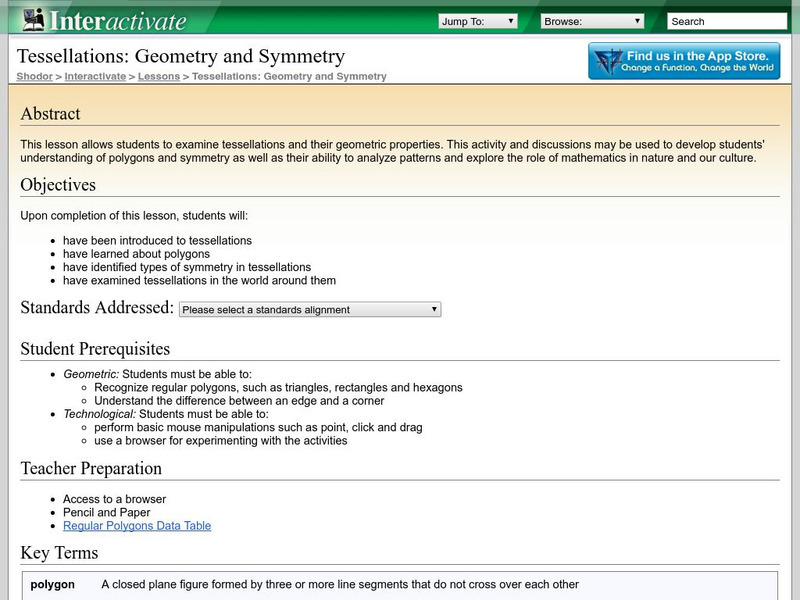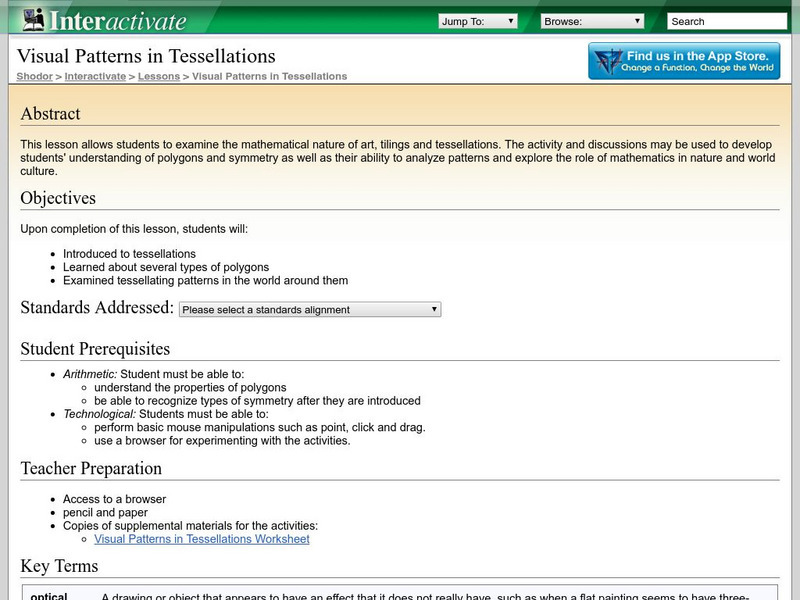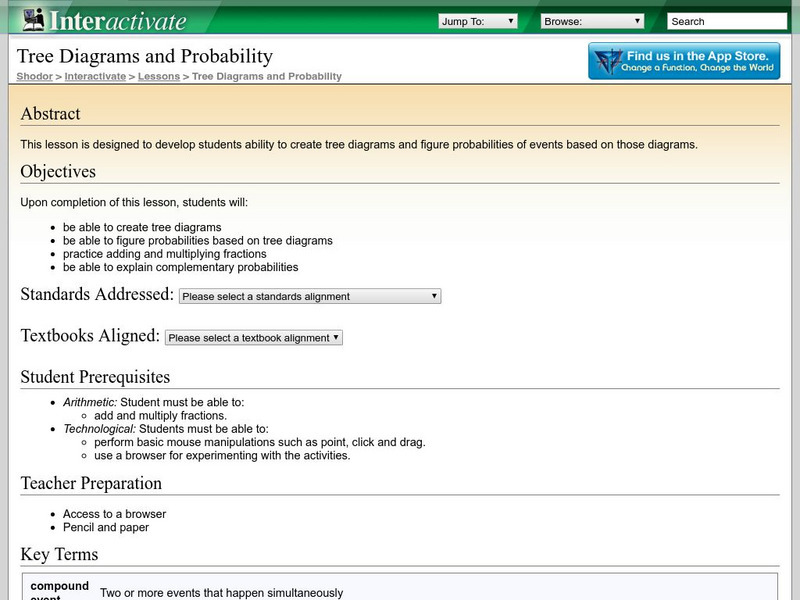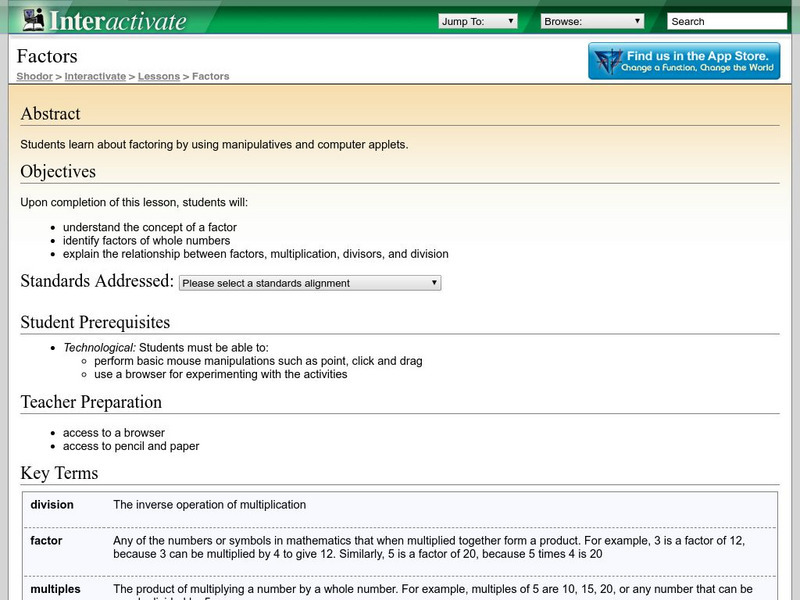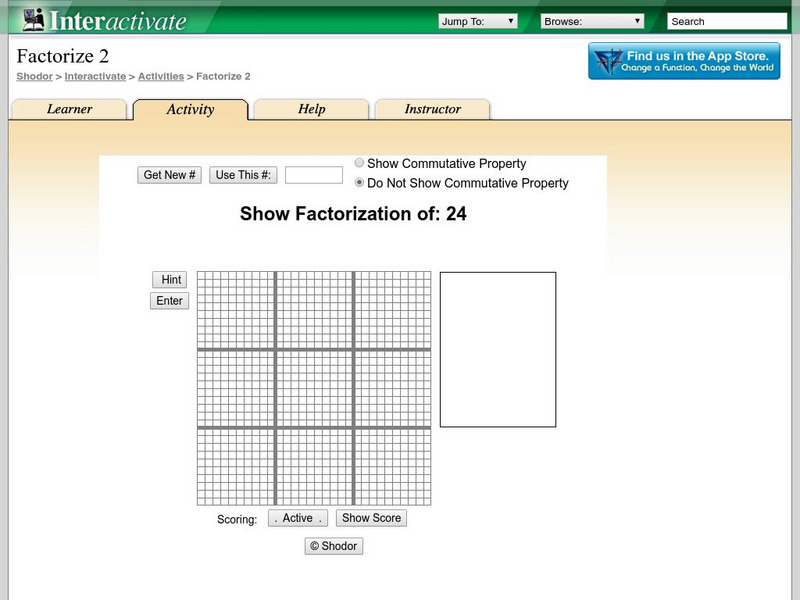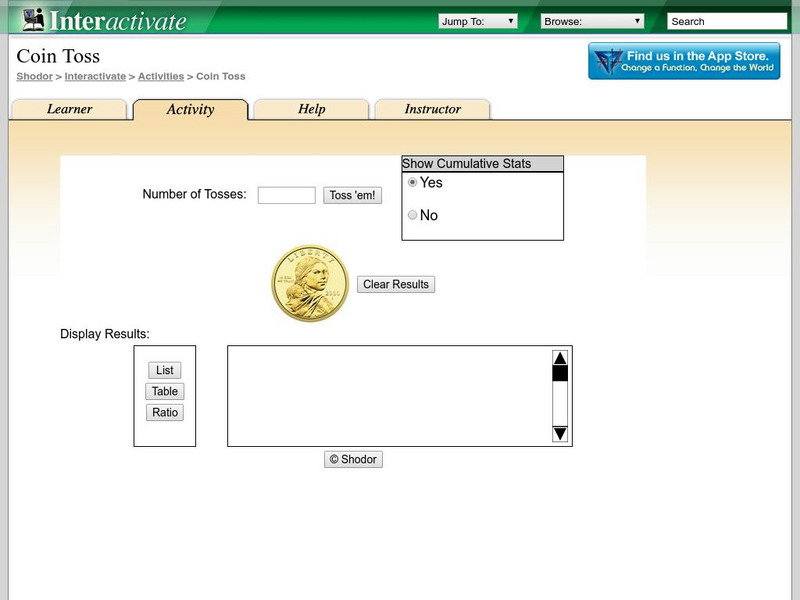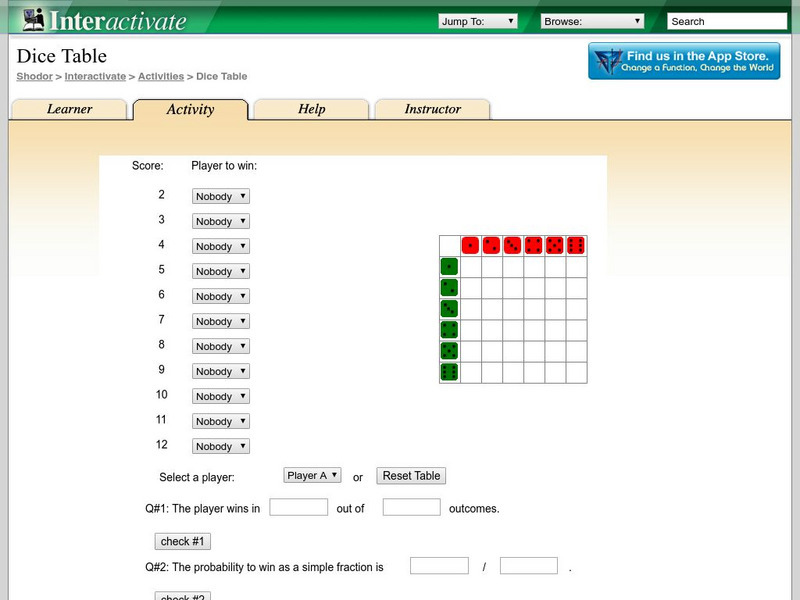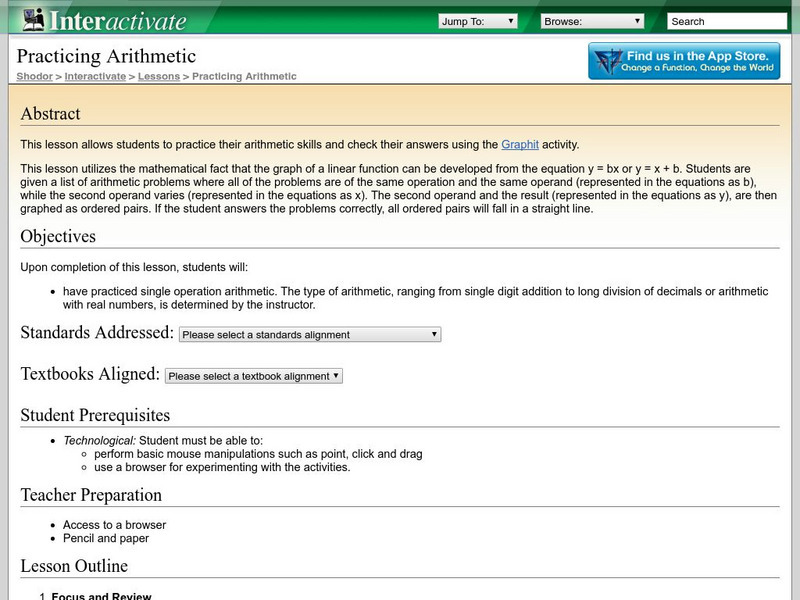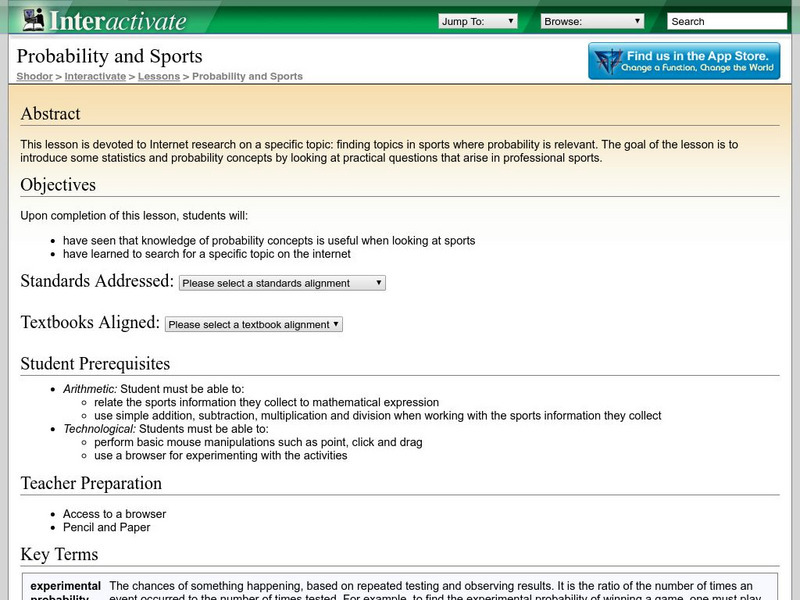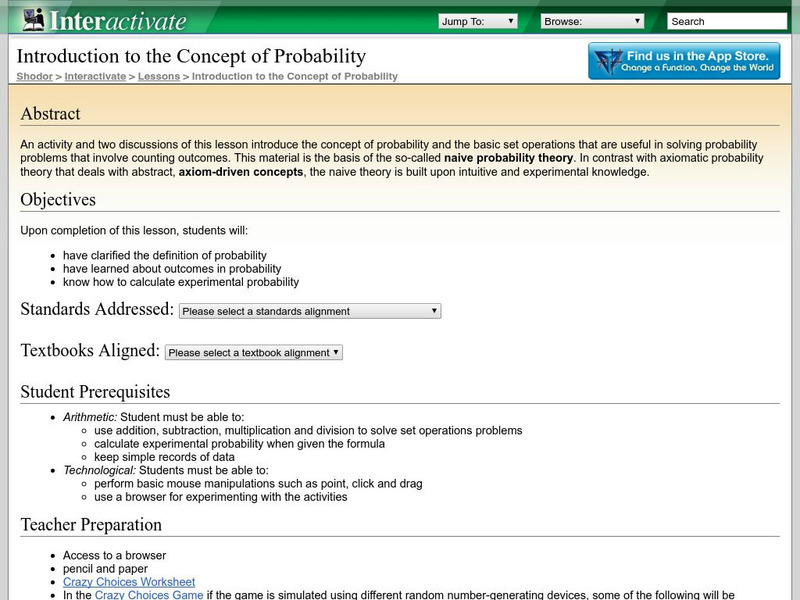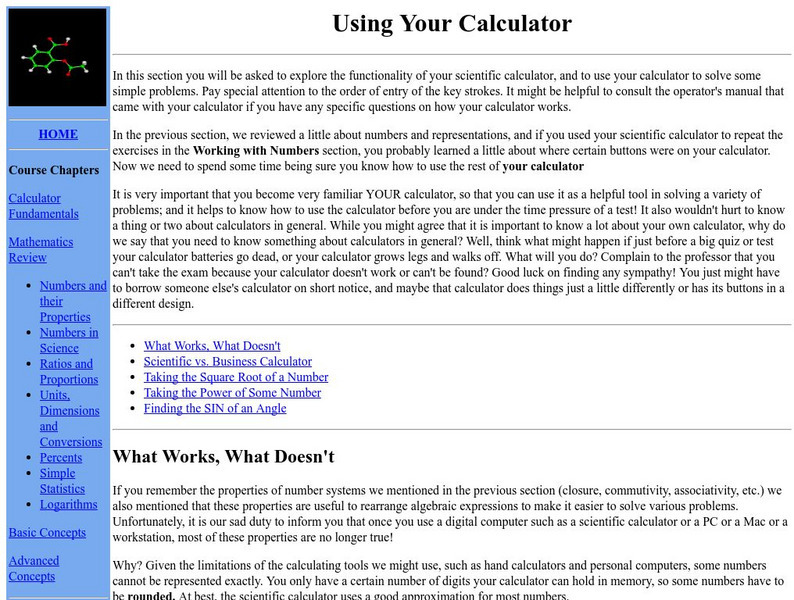Shodor Education Foundation
Shodor Interactivate: Lesson: Tessellations Geometry and Symmetry
This lesson plan deals with tessellations and their geometric concepts. Upper elementary and middle school students will also explore polygons, symmetry, analyze patterns and explore the role of mathematics in nature and culture.
Shodor Education Foundation
Shodor Interactivate: Lesson: Visual Patterns in Tessellations
This upper elementary and middle school lesson plan examines the mathematical nature of art, tilings and tessellations. Students will also explore polygons, symmetry, analyze patterns and explore the role of mathematics in nature and our...
Shodor Education Foundation
Shodor Interactivate: Lesson: Graphing and the Coordinate Plane
This lesson plan helps students understand how to graph ordered pairs on the coordinate plane. Lots of resources are available to teachers and students at this website.
Shodor Education Foundation
Shodor Interactivate: Lesson: Ideas That Lead to Probability
This lesson plan sets the ground work for an introduction to and then exploring the concepts that are the foundation for probability. Lots of resources are available for teachers and students at this website.
Shodor Education Foundation
Shodor Interactivate: Lesson: Tree Diagrams and Probability
This lesson plan helps young scholars develop tree diagrams and figure probability of events based on diagrams. Lots of resources are available to support teachers and students at this website.
Shodor Education Foundation
Shodor Interactivate: Lesson: Conditional and Simultaneous Probability
This lesson plan deals with conditional probability and the probability of simultaneous events. Problems included in this lesson tend to have solutions that are counterintuitive. This presents an opportunity to investigate more deeply...
Shodor Education Foundation
Shodor Interactivate: Lesson: Functions and the Vertical Line Test
This lesson plan outlines an activity that allows students to explore the vertical line test for functions.
Shodor Education Foundation
Shodor Interactivate: Lesson: Factors
For this lesson students will understand the concept of a factor, identify factors of whole numbers and explain the relationship between factors, multiplication, divisors, and division.
Shodor Education Foundation
Shodor Interactivate: Another Hilbert Curve Generator
The "Hilbert Curve Generator" activity helps students to visualize the steps in generating a Hilbert Curve fractal.
Shodor Education Foundation
Shodor Interactivate: Bar Graph Sorter
An applet allows students to sort shapes into a bar graph by color and shape. The learning resource consists of the activity, instructions, instructor notes, and additional resources.
Shodor Education Foundation
Shodor Interactivate: Factorize 2
The resource consists of student notes, instructor notes, and an interactive activity. The activity allows learners to find the factors of a given number and then draw the product as the area of a rectangle on a grid.
Shodor Education Foundation
Shodor Interactivate: Coin Toss
A simple coin-toss simulation through which students explore experimental probability. Accompanied by links to related activities, discussions, worksheets, and materials for instructors.
Shodor Education Foundation
Shodor Interactivate: Dice Table
A dice-table activity introduces young scholars to probability and to converting probability to a simple fraction, a decimal, and a percentage.
Shodor Education Foundation
Shodor Interactivate: Activities
Students have access to several activities to practice their algebra skills.
Shodor Education Foundation
Shodor: The Arrhenius Equation
This Shodor Educational Foundation site provides information on the Arrhenius equation and gives examples of its use.
Shodor Education Foundation
Shodor Interactivate: Stem and Leaf Plot
Shodor offers this interactive Stem and Leaf Plotter. The mean, median, and mode may be calculated or checked for accurracy with your given data. Be sure to check the "What?" link to find exercises and a lesson plan.
Shodor Education Foundation
Shodor Interactivate: Algebra Four
A game for two players to for a connect four type of game where students solve equations (several difficulty levels of quadratic and/or linear equations)to drop a chip.
Shodor Education Foundation
Shodor Interactivate: Lesson: Reading Graphs
Presents an introductory lesson to teach students how to read and plot graphs and determine functions based on graphs.
Shodor Education Foundation
Shodor Interactivate: Lesson: Arithmetic Practice W/ Ordered Pairs
The Shodor Education Foundation provides this lesson plan to have students practice simple computation that results in them graphing their answers. If they are accurate they will have a straight line. Students use an interactive...
Shodor Education Foundation
Shodor Interactivate: Lesson: Probability and Sports
The Shodor Education Foundation provides this lesson plan. In it, students explore where probability can be applied to professional sports. NCTM standards are listed for this lesson plan.
Shodor Education Foundation
Shodor Interactivate: Lesson: Intro to the Concept of Probability
The Shodor Education Foundation provides this lesson plan to introduce students to the concepts of probability. Students learn about the definition of, outcomes in, and calculations of experimental probability. Students use an...
Shodor Education Foundation
Shodor Interactivate: Lesson: Probability and Geometry
The Shodor Education Foundation provides this lesson plan to give students an opportunity to connect probabilty and geometry. Students learn how to calculate probability, use geometry to solve probabilty problems, and, as an added bonus,...
Shodor Education Foundation
Shodor: Using Your Calculator
This site deals with using a calculator to help solve and evaluate mathematical problems. This site provides a lengthy chart of basic operations performed by calculators, examples of problems to be solved using a calculator, as well as...
Shodor Education Foundation
Shodor Interactivate: Elapsed Time
Students can practice determining elapsed time when given a start time and an end time. They can switch between digital and analog clocks.


